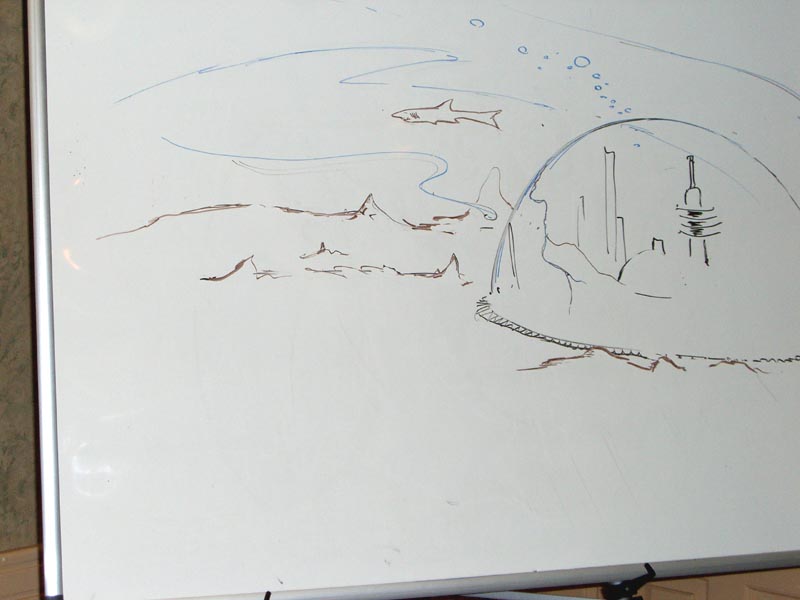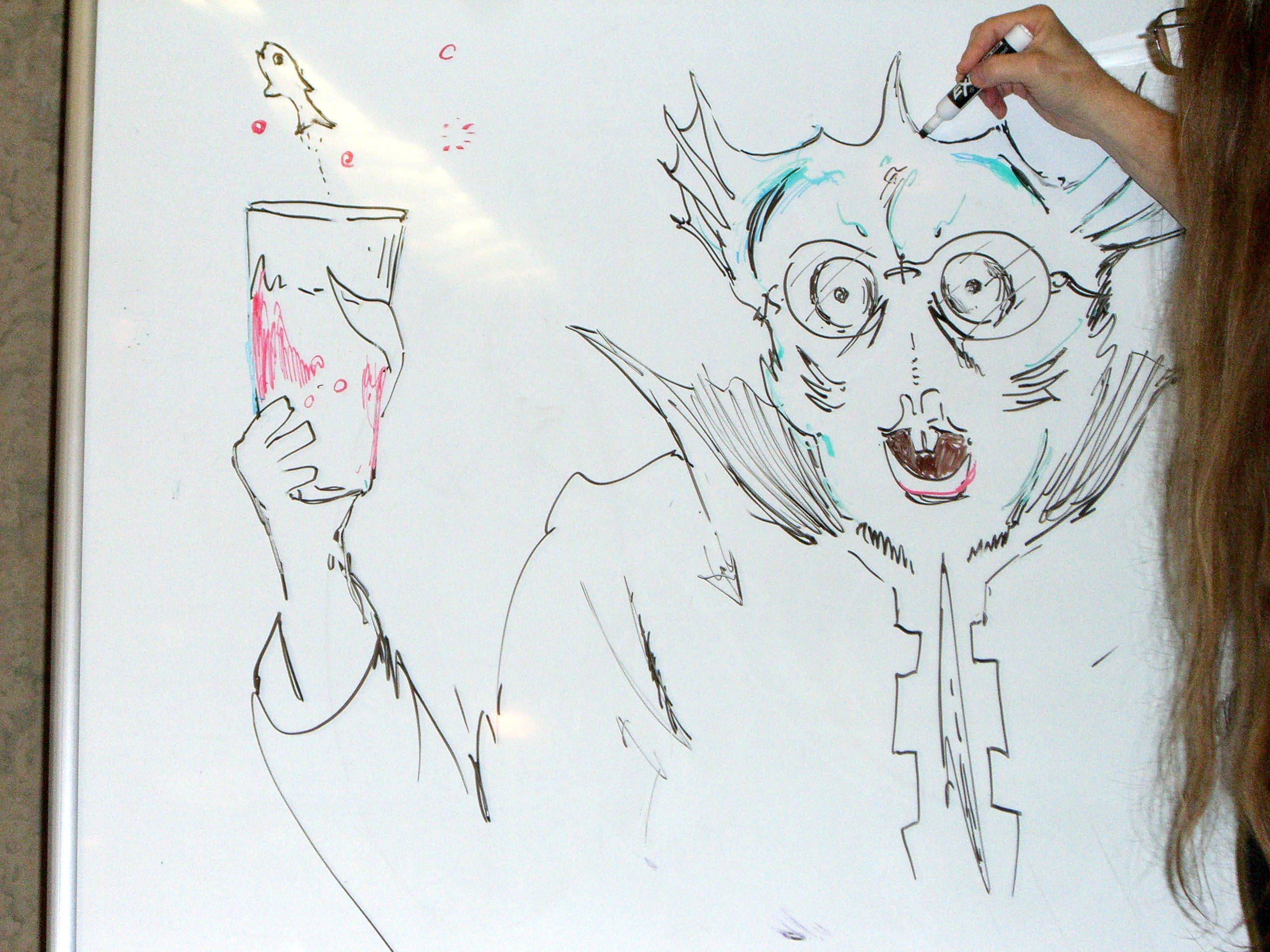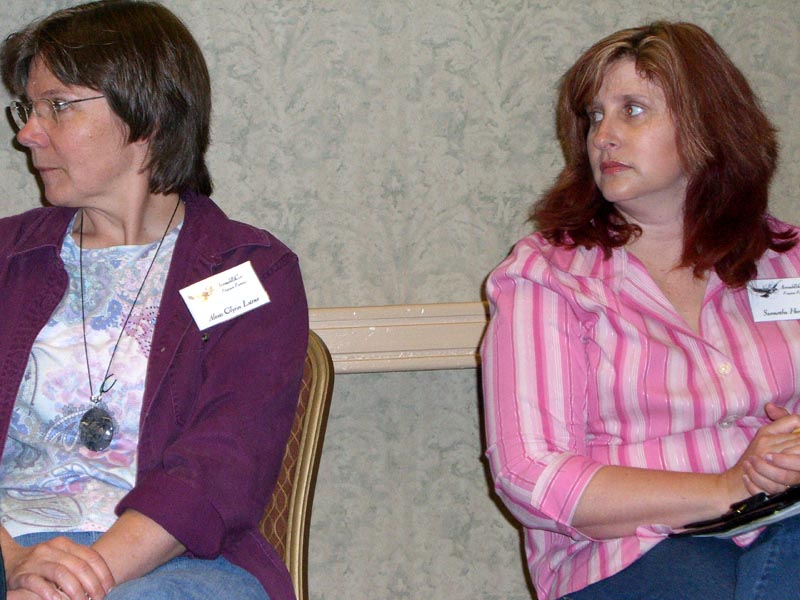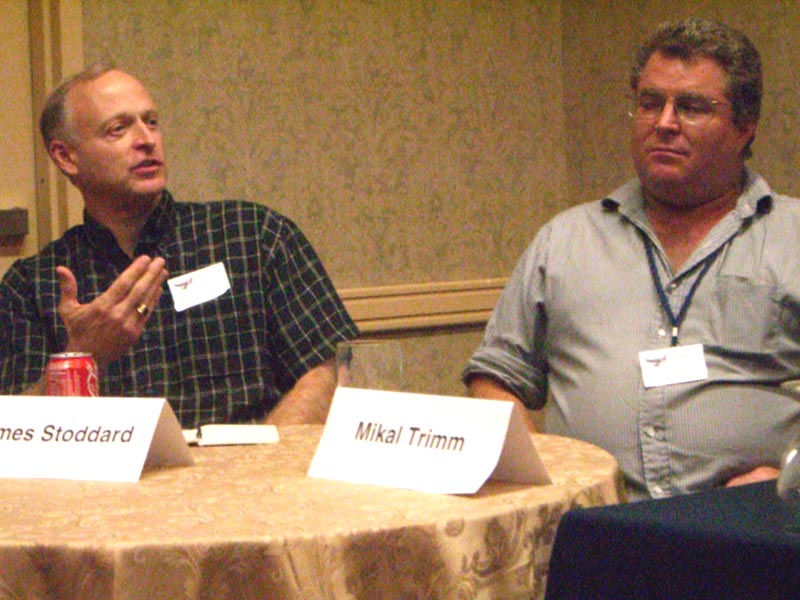Create a World: an ArmadilloCon 2007 panel
Every ArmadilloCon has a world-building panel, where the panelists and the audience “create” a science-fictional or fantasy world by collective brainstorming. Artist R. Cat Conrad often participates by drawing scenes from the world-in-progress on a whiteboard.
This year the panelists were Alexis Glynn Latner (moderator), Samantha Henderson, Rachel Caine, R. Cat Conrad, Deborah Chester, James Stoddard, and Mikal Trimm.
For starters, the panelists and the audience decide by voting: are they building a science fiction or a fantasy world? The audience is almost equally split between the two, but, but science fiction prevails by a small margin.
To keep the scope of the task manageable, we’ll focus on one city in this world we are building. The city is half-submerged in water. Or it may be fully submerged and exist under a dome of a force field. What kind of inhabitants will it have? What kind of conflicts will arise in this society? They may arise from the different species’ fight for dominance, or natural cataclysms. What kind of religion will they have, and what part will it play in the conflict? What myths will this society tell itself? And finally, some silly touches.
The submerged city under a dome of a force field. A drawing by R. Cat Conrad.

Its inhabitants may have evolved into aquatic species. It’s not impossible, says Rachel Caine: iguanas in the Galapagos islands have evolved to be able to stay submerged underwater much longer than other iguanas, so that they could eat algae on the ocean floor. Or there may be two species. One is the same old human race, and it continues to live on dry land; the other is an aquatic species that evolved from humans.
The conflict
The two-species situation is ripe for conflict. Which species will be dominant? If the majority of the planet is under water, then it’s logical that the land-dwelling race may feel besieged, or at least insecure. They are at a disadvantage (more so if the water level keeps rising), and they may try hard to preserve their status quo with the aquatic race. Perhaps they have high technologies that they can trade with the water people. Or maybe the aquatic race has been genetically modified to be subservient to the land dwellers, to respond to their demands, kind of like dogs do, while preserving human-like intelligence? (James Stoddard)
In this kind of setup it is very tempting to throw a Romeo-and-Juliet interspecies romance angle into the story, says Mikal Trimm.
The plot-driving conflict may also be prompted by catastrophic natural events. Perhaps an asteroid hits the city, destroying some of the underwater habitats, starting a fight for resources (suggested by a guy in the audience). Or it doesn’t have to be an earthquake, it can be something as simple as the change in the water currents (Mikal Trimm). Or the water may become polluted, ruining the life conditions of the aquatic species. The panelists call this possibility “red tide”, and it makes its way into R. Cat Conrad’s drawing (see picture).
Below is a portrait of the aquatic species by R. Cat Conrad. The red liquid in the glass is symbolic of the “red tide” — polluted water that spells disaster to the aquatic species. The fish is trying to jump out because the water is so unlivable.

Having fresh water is extremely important, since we can’t survive on salt water (Mikal Trimm). Perhaps a handful of scientists are trying to develop a technology to desalinate the water, and that’s taken as a heresy by the powers-that-be (Rachel Caine). If the water people are developing this technology (or tinkering with their own genes to be able to live on saltwater), it would create a huge power imbalance in favor of the water species, and that could drive the conflict (Samantha Henderson). Or maybe the air people are learning to control climate, so as to bring rains that would bring fresh water to the city. (Alexis Glynn Latner)
Or maybe the plot-driving conflict arises not a natural cataclysm, but from a war between separate submerged communities on this planet. By the way, we still haven’t decided, are there going to be other cities in this world, or is ours the only one? If there are others, are they submerged too? What are their relationships with “our” city? Trade? War? Uneasy truce punctuated by raids? Rachel Caine says maybe “our” city stayed closed to the outside world for too long, and then the residents are suddenly made aware that there are other communities. “One day two guys from Houston ride into the city,” says Rachel Caine. Somebody else in the audience says Houston would have been underwater for a long time, so those guys would have to be from Denver, Colorado.
Religion / philosophy / psychology
In any case, if you are hanging by a thread to a way of life that’s slipping away, you are going to be fearful, resentful and close-minded. So the people “above” are going to resist any advancements that the aquatic people can provide, says Deborah Chester. The land people live in a religious, existential fear, that the water is going to keep rising, and the dry land is going to get smaller (Alexis Glynn Latner). They may have a religion with a savior who can live equally in both worlds (Mikal Trimm).
Panelists Alexis Glynn Latner (left) and Samantha Henderson

Every ArmadilloCon has a world-building panel, where the panelists and the audience “create” a science-fictional or fantasy world by collective brainstorming. Artist R. Cat Conrad often participates by drawing scenes from the world-in-progress on a whiteboard.
For starters, the panelists and the audience decide by voting: are they building a science fiction or a fantasy world? The audience is almost equally split between the two, but, but science fiction prevails by a small margin.
To keep the scope of the task manageable, we’ll focus on one city in this world we are building. The city is half-submerged in water. Or it may be fully submerged and exist under a dome of a force field. What kind of inhabitants will it have? What kind of conflicts will arise in this society? They may arise from the different species’ fight for dominance, or natural cataclysms. What kind of religion will they have, and what part will it play in the conflict? What myths will this society tell itself? And finally, some silly touches.
ArmadilloCon is a speculative fiction convention that takes place every year in Austin, Texas.
Austin, Texas, July 2007
The inhabitants of this world may have no idea how the world became this way. It’s a mystery where the two races came from. But since the land-dwelling race, being closer to their common predecessor, looks like the gods and saints in the old religious pictures, they consider themselves superior (Samantha Henderson). The aquatic race may aspire to one day become more like the land-dwelling race, not realizing that they are the more advanced ones (Mikal Trimm).
Or people may be worshipping water itself, especially fresh water. That in itself can drive the conflict, as we mentioned above: creating fresh water artificially may be perceived as heresy.
Infrastructure
If there are other submerged cities on this planet, what do their inhabitants use for transportation and long-distance communication? Dolphins, naturally. Everyone who lives in the water knows how to catch a ride on a dolphin (Mikal Trimm). Rachel Caine likes an idea of marathon swimmers who carry messages. Communication may not be verbal anymore, but shifts of temperature in the water that carry the messages (Mikal Trimm). James Stoddard points out that at 4000 feet the difference between temperature and water pressure is such that you can create a tunnel of sound. A strong enough sound can travel all around the world. Rachel Caine adds that whales use that to communicate. So sound may be the best way to communicate underwater, despite other interesting possibilities. Caine also mentions that octopuses communicate with other octopuses by flashing their colors. It’s a dazzling show of colors.

Other vivid details
Alexis Glynn Latner says the water people may need special suits, akin to space suits, to go on the surface. The colors of the suit may be the only way to communicate a person’s identity. So if you wear wrong person’s clothes, it can be dangerous. Maybe the colors of suits is the only way the land people can tell water people apart. So if the water people want to deceive land people, all they have to do is to put on a different person’s suit (Mikal Trimm).
To add a lighter touch, we may think about what kinds of pets water people keep. Fish would be a natural choice, of course, but perhaps they keep squirrels in air bubbles?